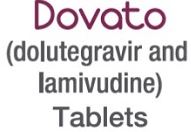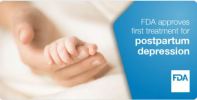
ZULRESSO (brexanolone) intravenous injection
Sage Therapeutics
INDICATION: Treatment of postpartum depression (PPD) in adults
ADDRESSING UNMET NEED:
- First drug approved specifically for PPD
- PPD is a serious condition that can be life-threatening
MECHANISM OF ACTION: Related to positive allosteric modulation of GABA receptors
EFFICACY:
- Two multicenter, randomized, double-blind, women (18 to 45 years) with PPD, ZULRESSO vs placebo
- Primary endpoint: Mean change from baseline in depressive symptoms as measured by HAM-D total score at the end of the infusion
- Superiority to placebo in improvement of depressive symptoms, improvement in depression was also observed at the end of the 30-day follow-up period.
SAFETY:
- Boxed Warning: Patients at risk of excessive sedation or sudden loss of consciousness during administration; must be monitored for excessive sedation and sudden loss of consciousness and have continuous pulse oximetry monitoring
- Most common adverse reactions: Sleepiness, dry mouth, loss of consciousness and flushing
REGULATORY PATHWAY: NDA
- Priority Review and Breakthrough Therapy designations
- Approved with a Risk Evaluation and Mitigation Strategy (REMS)- only available through restricted distribution program
- Recommend scheduling of Zulresso under the Controlled Substances Act (CSA)- DEA scheduling pending
- Required Pediatric Assessment: In adolescent females, 15 – <18 diagnosed with postpartum depression.
 SUNOSI (solriamfetol) tablets
SUNOSI (solriamfetol) tablets
Jazz Pharmaceuticals
INDICATION: To improve wakefulness in adult patients with excessive daytime sleepiness associated with narcolepsy or obstructive sleep apnea (OSA)
MECHNANISM OF ACTION: Could be mediated through its activity as a dopamine and norepinephrine reuptake inhibitor
EFFICACY:
Narcolepsy
- 12-week, multi-center, randomized, double-blind, placebo-controlled,
parallel-group study, n=239 patients with narcolepsy - Co-primary Endpoints: Maintenance of Wakefulness Test (MWT) and Epworth Sleepiness Scale (ESS). Statistically significant improvements with SUNOSI
OSA:
- 12-week multi-center, randomized, double-blind, placebo-controlled study, n=476 patients with OSA
- Statistically significant improvements with SUNOSI on MWT and ESS
SAFETY:
- Warnings and Precautions: Blood Pressure and Heart Rate Increases, Psychiatric Symptoms
- Most common adverse reactions: Headache, nausea, decreased appetite, insomnia, anxiety.
REGULATORY PATHWAY: NDA
- Recommended scheduling under Controlled Substances Act (CSA)- DEA scheduling pending
- Postmarketing requirements: Prospective, registry study on maternal, fetal, infant outcomes, additional pregnancy study, lactation study
 MAYZENT (siponimod) tablets
MAYZENT (siponimod) tablets
Novartis
INIDCATION: Treatment of relapsing forms of multiple sclerosis (MS), to include clinically isolated syndrome, relapsing-remitting disease, and active secondary progressive disease, in adults.
ADDRESSING UNMET NEED:
- MS is among the most common causes of neurological disability in young adults and occurs more frequently in women than in men
- Can have a profound impact on person’s life
- Approval provides a treatment option
MECHANISM OF ACTION: Sphingosine-1-phosphate (S1P) receptor modulator; binds with high affinity to S1P receptors- reduces lymphocyte migration into CNS
EFFICACY:
- Randomized, double-blind, parallel-group, placebo-controlled, time-to-event study, n=1651 in patients with secondary progressive multiple sclerosis (SPMS), MAYZENT vs placebo
- Primary endpoint: Time to three-month confirmed progression in disability
- Progression of disability statistically significantly lower in Mayzent vs. placebo
- Decreased number of relapses group with Mayzent
SAFETY:
- Medication Guide: May increase the risk of infections, may cause macular edema, may cause transient decreases in heart rate and may cause a decline in lung function and liver fucntion
- Most common adverse reactions: Headache, high blood pressure and liver function test increases
REGULATORY PATHWAY: NDA
- Postmarketing requirements: Clinical Study to assess serious risk of pulmonary toxicity, Prospective pregnancy exposure registry, Pregnancy outcomes study
 Dovato (dolutegravir and lamivudine) tablet
Dovato (dolutegravir and lamivudine) tablet
ViiV Healthcare
INDICATION: complete regimen for the treatment of human immunodeficiency virus type 1 (HIV-1) infection in adults with no antiretroviral treatment history and with no
known substitutions associated with resistance to the individual components of DOVATO
ADDRESSING UNMET NEED:
- First FDA-approved two-drug, fixed-dose, complete regimen for HIV-infected adults who have never received treatment for HIV
- Drug-sparing treatment available that uses fewer drugs is beneficial to patients who may have issues taking multiple medications over a long period of time
MECHANISM OF ACTION: Fixed-dose combination of the HIV-1 antiretroviral agents, dolutegravir and lamivudine
EFFICACY:
- Two identical, randomized, double-blind, controlled clinical trials, n=1,433 HIV-infected adults with no prior antiretroviral treatment history
- Primary efficacy endpoint: Proportion of subjects with plasma HIV-1 RNA <50 copies/mL at Week 48
- Dovato had similar effect of HIV reducion vs drug regimen of dolutegravir, emtricitabine, and tenofovir
SAFETY:
- Boxed Warning: Patients infected with both HIV and hepatitis B should add additional treatment for hepatitis B
- Known risk for neural tube defects with dolutegravir- avoid use at the time of conception through first trimester of pregnancy
- Most common adverse reactions: Headache, diarrhea, nausea, insomnia and fatigue
REGULATORY PATHWAY: NDA
- Supportive of DHHS initiative Ending the HIV Epidemic: A Plan for America,
- Aim to reduce new infections by 75% in the next 5 years and by 90% in the next 10 years, averting more than 250,000 HIV infections in that span
 BALVERSA (erdafitinib) tablets
BALVERSA (erdafitinib) tablets
Janssen
therascreen FGFR RGQ RT-PCR Kit
Qiagen
INDICATION: Treatment of adult patients with locally advanced or metastatic
urothelial carcinoma (mUC), that has:
- susceptible FGFR3 or FGFR2 genetic alterations, and
- progressed during or following at least one line of prior platinum-containing chemotherapy, including within 12 months of neoadjuvant or adjuvant platinum-containing chemotherapy.
Select patients for therapy based on an FDA-approved companion diagnostic for BALVERSA
ADDRESSING UNMET NEED: First personalized treatment targeting susceptible FGFR genetic alterations for patients with metastatic bladder cancer
MECHANISM OF ACTION: Kinase inhibitor that binds to and inhibits enzymatic activity of FGFR1, FGFR2, FGFR3 and FGFR4; inhibits FGFR phosphorylation and signaling and decreased cell viability in cell lines expressing FGFR genetic alterations
EFFICACY:
- Multicenter, open-label, single-arm study, n=87 patients with locally advanced or metastatic bladder cancer, with FGFR3 or FGFR2 genetic alterations, that had progressed following treatment with chemotherapy
- Major efficacy outcome measures: Objective response rate (ORR), Duration of response (DoR), determined by blinded independent review committee (BIRC) according to RECIST v1.1
- ORR: 32.2%, with 2.3% having complete response and 30% having partial response
- DOR: Approximately five-and-a-half months
- Responses to Balversa were seen in patients who had previously not responded to anti PD-L1/PD-1 therapy
SAFETY:
- Warnings and Precautions: Ocular disorders, Hyperphosphatemia
- Common side effects: Increased phosphate level, mouth sores, feeling tired, change in kidney function, diarrhea, dry mouth, nails separating from the bed or poor formation of the nail, change in liver function, low salt (sodium) levels, decreased appetite, change in sense of taste, low red blood cells (anemia), dry skin, dry eyes and hair loss. Other side effects include redness, swelling, peeling or tenderness on the hands or feet (hand foot syndrome), constipation, stomach pain, nausea and muscle pain
- Balversa because it may cause harm to a developing fetus or newborn baby
REGULATORY PATHWAY: NDA
- Accelerated Approval, Breakthrough Therapy designation
- Accelerated approval based on tumor response rate – Continued approval may be contingent upon verification and description of clinical benefit in confirmatory trials
- Accelerated approval requirements: Demonstrating clinical benefit of erdafitinib in patients with locally advanced and metastatic urothelial carcinoma with susceptible FGFR 3 or FGFR 2 genetic alterations
Image credit: Sage, Jazz, Novartis, ViiV, Janssen
